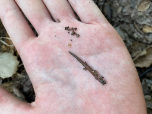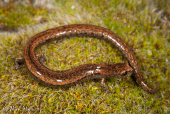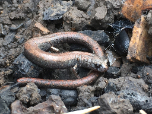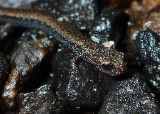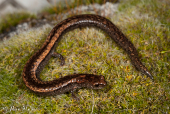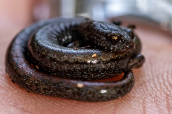Black-Bellied Slender Salamander (Batrachoseps nigriventris)
Description: Adults are 1 1/4 - 1 7/8 inches long from snout to vent. A small slim salamander with 18 - 21 costal grooves. Short limbs, a narrow head, long slender body, very long tail, and conspicuous costal and caudal grooves give this species the worm-like appearance typical of most Slender Salamanders.
There are four toes on the front and hind feet, which is typical of Slender Salamanders. (Other salamanders found in California have five toes on the hind feet.)
The tail may be up to twice the body length on adults found on the mainland, but only about the size of the body length on adults from Santa Cruz Island. Color above is dark brown or blackish with a reddish, brown, or tan dorsal stripe. The venter is dark with fine white speckling.
Habitat: Inhabits mostly oak woodlands but also found in chaparral, grasslands, streamsides, and oak and pine forests. Found under rocks, logs, bark, and other debris in moist areas. On Santa Cruz Island, occurs in streamside Eucalyptus forest, under coastal driftwood, in oak woodland, and in open grassland.
South of the Tehachapi Mountains, this species is found mostly in moist mountain and foothills canyons.
Range: Endemic to California. Found in mountains and valleys of the coast range from southern Monterey County south to the Santa Ana Mountains, including the Tehachapi, Santa Monica and San Gabriel Mountains east to Cajon Pass. Also found on Santa Cruz Island.
Found in these States:
CA
Diet: Eats a variety of small invertebrates. Feeding behavior is not well known, but other Batrachoseps species are sit-and-wait predators that use a projectile tongue to catch prey.
Reproduction: Little is known about the Breeding behavior and egg-laying habits of this species. Reproduction is terrestrial. Slender Salamanders typically lay eggs in moist places on land. In southern California, B. nigriventris lays eggs in the winter which hatch in winter and early spring.
Eggs have been found in early December in the Coast Range. Young develop completely in the egg and hatch fully formed.
Status: Listed as Least Concern in view of its relatively wide distribution, tolerance of a broad range of habitats and presumed large population.
»» Kingdom: Animalia - Animals
»» Phylum: Chordata - Chordates
»» Subphylum: Vertebrata - Vertebrates
»» Class: Amphibia - (Amphibians)
»» Order: Caudata - Salamanders
»» Family: Plethodontidae - Lungless Salamanders
»» Genus: Batrachoseps
»» Species: Batrachoseps nigriventris - Black-Bellied Slender Salamander
This article uses material from the Wikipedia article "Black-Bellied Slender Salamander", which is released under the Creative Commons Attribution-Share-Alike License 3.0. Content may have been omitted from the original, but no content has been changed or extended.
|


